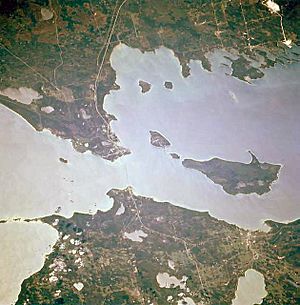Michilimackinac facts for kids
Michilimackinac (pronounced MISH-uh-luh-MACK-uh-naw) is an old name that comes from the Ottawa and Ojibwe Native American tribes. It refers to the area around Mackinac Island and the Straits of Mackinac. This is a narrow waterway that connects Lake Huron and Lake Michigan.
Long ago, early European settlers used the name Michilimackinac for a much larger area. This included the lands around Lakes Huron, Michigan, and even Superior. Today, most of this historic area is found within the state of Michigan in the United States. Michilimackinac was also the first name for what we now call Mackinac Island and Mackinac County.
Contents
History of Michilimackinac
Ancient Times (1000 BCE–1650 CE)
People have lived in the Michilimackinac area for a very long time. Around 3,000 years ago, they started making pottery. This pottery style is known as the Laurel complex.
The people living here were also part of a large trade network. They traded goods with other groups over long distances. This was likely part of the Hopewell tradition, a big cultural movement in ancient North America.
Native Americans and the French (1612–1763)
The Straits of Mackinac were a very important place. They connected Lake Michigan and Lake Huron. This made them key for travel and trade in the "upper country" (Pays d'en Haut).
Native American nations, especially the Algonquian Anishinaabe tribes, controlled this area. These included the Ojibwa (also called Chippewa) and the Odawa. The Odawa called the area Michilimackinac, which means "Big Turtle." For these tribes, Michilimackinac was a very special place. It was seen as the "birthplace and center of the world." It was also where the Council of Three Fires met. This was a powerful alliance of the Ojibwe, Odawa, and Potawatomi tribes.
The Anishinaabe tribes had good relationships with the Wyandot people. The Wyandot were the first Native American group to meet the French. This happened after Samuel de Champlain arrived in 1608. The Anishinaabe used these connections to trade with the French indirectly.
The French were the first Europeans to explore the Michilimackinac area. They started arriving in 1612. After a series of wars called the Beaver Wars, the Anishinaabe began trading directly with the French. They even invited French settlers to live in Michilimackinac.
In 1654, a large group of Iroquois warriors tried to cross the straits. But the Odawa and Ojibwe tribes attacked them. The Iroquois tried again in 1658 but were defeated once more by the Anishinaabe.
The French set up trading posts and Jesuit Catholic missions. One of the oldest missions was St. Ignace Mission. It was built in 1671 by the Jesuit priest Jacques Marquette. This mission was on the north side of the strait, near what is now St. Ignace, Michigan.
In 1683, the French built a fort on the north side of the straits. This was part of an alliance with the Anishinaabe against the Iroquois. Between 1670 and 1700, Michilimackinac became a very busy place. It was one of the most important centers for the fur trade.
French visitors reported that huge summer markets happened every year along the shores. Both Native Americans and newcomers came to trade. Hundreds of Native Americans from around Lakes Michigan and Superior traveled to the straits. They met French traders who came up from the St. Lawrence River. Michilimackinac became a "landing place and refuge" for all the Native Americans who traded furs. It was also the main meeting spot for all the French traders.
In 1715, the French built a new fort and settlement on the south side of the strait. They called it Fort Michilimackinac. This fort became a major trading hub. It attracted Native Americans from all over the northern Great Lakes region.
Later, Great Britain defeated France in the Seven Years' War (also known as the French and Indian War). The British then took control of Fort Michilimackinac and the surrounding territory.
British and American Control
In 1763, the Ojibwa tribe attacked Fort Michilimackinac during a Native American uprising. This event is sometimes called Pontiac's War. The British took the fort back in September 1764.
During the American Revolution, the British commander Patrick Sinclair moved the trading and military post. He moved it from Fort Michilimackinac to Mackinac Island in 1780. The British held Mackinac Island for some time. Fort Michilimackinac was then left empty.
After the American colonies won their independence, the old fort site became part of the United States. The fort saw its only military action on July 17, 1812. During the War of 1812, Lieutenant Porter Hanks surrendered the fort to the British without a fight.
Today, Fort Michilimackinac is a popular tourist spot. People dressed in historical costumes show what life was like for the French and English. You can also watch an archeological dig happening at the site.


